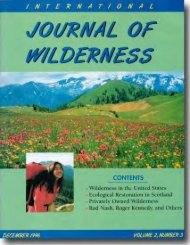Download full PDF - International Journal of Wilderness
Download full PDF - International Journal of Wilderness
Download full PDF - International Journal of Wilderness
Create successful ePaper yourself
Turn your PDF publications into a flip-book with our unique Google optimized e-Paper software.
monarchs (de facto strict nature reserves),<br />
and peripheral forest compartments,<br />
used by the rangers and their<br />
families. The royal forest system lasted<br />
almost 300 years.<br />
By the end <strong>of</strong> 18th century, there<br />
was no other forest in Europe with<br />
woodland bison, a species that historically<br />
was common in most parts <strong>of</strong><br />
Europe. There were some grazing and<br />
game-breeding policies at the turn <strong>of</strong><br />
19th and 20th centuries, but the BPF<br />
was maintained almost unmanaged.<br />
Occasional forest harvesting occurred<br />
in the BPF when Russians ruled the<br />
area in the 19th century. During World<br />
War I (1914–1918), Germans began<br />
systematic industrial harvesting in the<br />
BPF. Since then the BPF has been<br />
gradually transformed into an area<br />
with a system <strong>of</strong> managed forestland.<br />
Post–World War I political chaos<br />
allowed for excessive poaching that<br />
•<br />
The lowland forest ecosystem in the Bialowieza Primeval Forest. Photo by Andrzej Bobiec.<br />
extirpated bison from their last natural<br />
forest range by 1919. In 1921, the<br />
nature preserve was designated on<br />
4,700 hectares (11,500 acres) in a central<br />
part <strong>of</strong> the BPF. The area was managed<br />
as a nature sanctuary and was<br />
soon designated as the BNP, the first<br />
national park in Poland. The founder<br />
<strong>of</strong> the BNP, Pr<strong>of</strong>essor W. Szafer, believed<br />
that national parks and nature<br />
reserves should remain “laboratories<br />
<strong>of</strong> wild nature and evolution.” After<br />
World War II, the BPF was divided<br />
into the Polish and Belarussian areas.<br />
The Belarussian area was used as a special<br />
hunting ground for Communist<br />
Party members until 1991, when it<br />
was protected as a National Park.<br />
According to the last forest inventory<br />
on the Polish BPF in 2001, forest<br />
stands that were 100 years old and<br />
older covered some 23% <strong>of</strong> the BPF.<br />
Over 30% <strong>of</strong> the BPF was secondary<br />
•<br />
The Bialowieza Primeval Forest is considered a natural<br />
heritage because <strong>of</strong> its long history <strong>of</strong> preservation<br />
and involvement <strong>of</strong> local communities.<br />
34 <strong>International</strong> <strong>Journal</strong> <strong>of</strong> <strong>Wilderness</strong> DECEMBER 2002 • VOLUME 8, NUMBER 3<br />
60-to 80-year old stands that developed<br />
naturally on old, nonreplanted clearings.<br />
There is no other forest in Europe<br />
with such a large surface representing<br />
a well-advanced natural succession<br />
after the historic clearing <strong>of</strong> natural<br />
stands. Most importantly, the entire BPF<br />
could be protected like the BNP.<br />
What Have We Preserved?<br />
The BPF is considered a natural<br />
heritage because <strong>of</strong> its long history <strong>of</strong><br />
preservation and involvement <strong>of</strong> local<br />
communities. Some serious concerns<br />
remain about the future <strong>of</strong> the BPF.<br />
The most well-known achievements<br />
following protection efforts in<br />
the BPF was successful restoration <strong>of</strong><br />
a viable wild herd <strong>of</strong> European bison<br />
(approximately 600 animals are alive<br />
today in herds within Poland and<br />
Belarus) and the longest history <strong>of</strong><br />
preservation in the BNP area. Ironically,<br />
establishment <strong>of</strong> the BNP has<br />
institutionalized the legal division <strong>of</strong><br />
the BPF into areas for protecting natural<br />
forest processes and conditions,<br />
and a production forest, managed according<br />
to national forest management<br />
legislation. While the BNP is an important<br />
achievement, it requires that<br />
the management <strong>of</strong> the surrounding<br />
BPF supports the preservation <strong>of</strong> the<br />
BNP flora and fauna. For example, sustaining<br />
the woodland bison requires a<br />
larger range than the BNP provides,<br />
and these charismatic megafauna are<br />
the public symbols <strong>of</strong> naturalness for<br />
the BPF area. Less well-known and<br />
important species need protected area<br />
status to survive and thrive, such as<br />
wolves, or birds that nest in cavities<br />
<strong>of</strong> dead trees.<br />
In an increasingly urban and agricultural<br />
world, rare and endangered<br />
forest ecosystems are dependent on<br />
protected late successional stages <strong>of</strong><br />
natural communities. The biodiversity<br />
<strong>of</strong> the old-growth forest in the BNP is a










